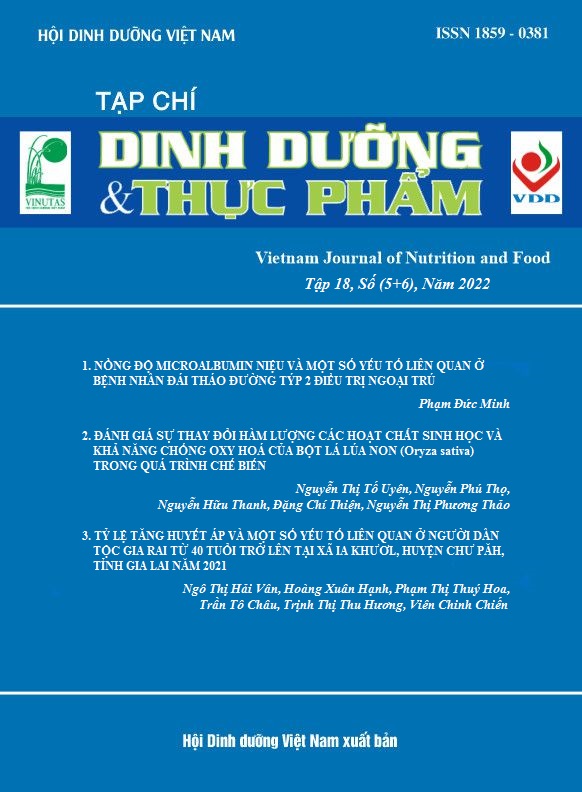ẢNH HƯỞNG CỦA PHƯƠNG PHÁP CHẦN, NỒNG ĐỘ GIẤM VÀ THỜI GIAN BẢO QUẢN ĐẾN CHẤT LƯỢNG SẢN PHẨM MÍT THÁI NON NGÂM GIẤM
Nội dung chính của bài viết
Tóm tắt
Mục tiêu: Xác định các yếu tố ảnh hưởng nhằm xây dựng quy trình sản xuất mít Thái (Artocarpus heterophyllus) non ngâm giấm.
Phương pháp: Thí nghiệm được thực hiện trên cơ sở tiến hành khảo sát ảnh hưởng của thời gian xử lý mít non (chần bằng hơi nước trong 30, 60, 90 giây), nồng độ giấm (pH 2, pH 2,5 và pH 3) và thời gian bảo quản ( 1-3 ngày, 6-8 ngày và 12-14 ngày) ở cả nhiệt độ mát (khoảng 5oC) và nhiệt độ phòng đến chất lượng mít Thái non ngâm giấm thông qua đánh giá hàm lượng đường khử, tổng polyphenol và acid tổng trong sản phẩm.
Kết quả: Kết quả cho thấy thời gian chần bằng hơi nước trong 90 giây là phù hợp nhất do giữ được nhiều hàm lượng polyphenol (14,98 mg/g). Ở pH 2,5 hàm lượng polyphenol vẫn được giữ ở mức cao (6,86 mg/g). Mít Thái non ngâm giấm bảo quản trong 1-14 ngày ở nhiệt độ mát là tốt nhất vì vẫn giữ được hàm lượng polyphenol 6,45 mg/g.
Kết luận: Sản phẩm này được chế biến từ nguyên liệu trái mít Thái non nhằm tận dụng phế phẩm nông nghiệp và đa dạng hóa sản phẩm từ mít.
Từ khóa
Mít Thái non, muối chua, chất lượng, nồng độ giấm
Chi tiết bài viết
Tài liệu tham khảo
2. Jagtap UB, Panaskar SN, and Bapat VA. Evaluation of antioxidant capacity and phenol content in jackfruit (Artocarpus heterophyllus Lam.) fruit pulp. Plant Foods for Human Nutrition. 2010;65:99–104.
3. Soong YY, and Barlow PJ. Antioxidant activity and phenolic content of selected fruit seeds. Food Chemistry. 2004;88:411–417.
4. Jagtap UB, and Bapat VA. Artocarpus: a review of its traditional uses, phytochemistry and pharmacology. Journal of Ethnopharmacology. 2010;129:142–166.
5. Saxena A, Bawa AS, and Raju PS (2011). Chapter 12- Jackfruit (Artocarpus heterophyllus Lam.). Elhadi, M.Y. Postharvest biology and technology of tropical and subtropical fruits - Volume 3: Cocona to Mango. Woodhead Publishing. Pages 275-299.
6. Moreno-Arribas MV, and Polo MC. Winemaking biochemistry and microbiology: current knowledge and future trends. Critical Reviews in Food Science and Nutrition. 2005; 45: 265–286.
7. Okunowo WO, Okotore RO, and Osuntoki AA. The alcoholic fermentative efficiency of indigenous yeast strains of different origin on orange juice. African Journal of Biotechnology. 2005;4: 1290–1296.
8. Narendra, N.D., Gourab, M., Vaibhav, V.G., Venkata, D.V., and Chivukula, V. (2020). Pitfalls in the 3, 5-dinitrosalicylic acid (DNS) assay for the reducing sugars: Interference of furfural and 5-hydroxymethylfurfural. International Journal of Biological Macromolecules. 156: 180-185.
9. Wolfe, K, Wu X, and Liu LH. Antioxidant activity of apple peels. Journal of Agricultural and Food Chemistry. 2003;51: 609-614.
10. Maria EM, Elhadi MY, Ramiro B, et al. Chemical composition of mango (Mangifera indica L.) fruit: nutritional and phytochemical compounds. Frontiers in Plant Science. 2019;10: 1073.
11. Kristina LP, Stephen YN, Ross PH, and Dean GA. Quantitative assessment of citric acid in lemon juice, lime juice, and commercially-available fruit juice products. Journal of Endourology. 2008;22(3): 567–570.
12. Hong-Wei X, Zhongli P, Li-Zhen D, Hamed MEM, Xu-Hai Y, Arun SM, Zhen-Jiang G, and Qian Z. Recent developments and trends in thermal blanching – A comprehensive review. Information Processing in Agriculture. 2017;4(2):101-127.
13. Ramani V, and Kant U. Phenolics and enzymes involved in phenol metabolism of gall and normal tissues of Prosopis cineraria. Proceedings of the National Academy of Sciences. 1989;5: 417-420.
14. Vega GA, Lara E, Flores V, Scala DK, and Lemus M. Effect of selected pretreatments on convective drying process of blueberries. Food and Bioprocess Technology. 2012;5: 2797-2804.


